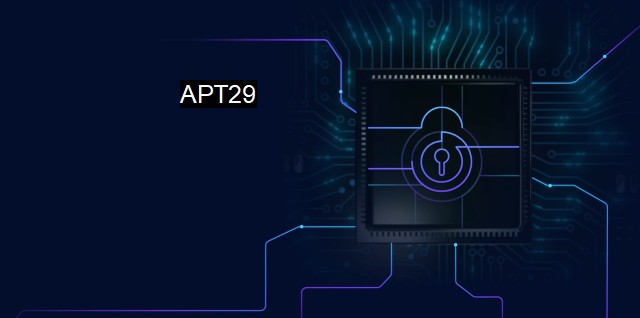What is APT29?
The Elusive Cozy Bear: A Closer Look at the Highly Sophisticated APT29 Cyber Espionage Group
APT29, also known as Cozy Bear, Dukes, or Office Monkeys, is a group of hacker spies regarded as several notches above the realms of mundane cybercriminals in the organization of cyberspace threats. They are believed to be backed by a nation-state, in this case, the Russian government, and are much bolder, sophisticated, and destructive in their operations than ordinary hackers. Earning their epithet as an Advanced Persistent Threat (APT), APT29 has become synonymous with persistent, advanced and organized cyber-espionage.Notably, APT29 operates in a highly untraceable and smart manner. They are known for using very sophisticated and carefully developed compound threats—a refined blend of rogue software, social engineering and AI algorithms that has been drafted to be highly adaptable and to become smarter with each successful seizure of their victims' cyberspace. Usually, they enter a network "quietly", spending a lot of time on reconnaissance, moving laterally, escalating privileges, and maintaining persistence in the victim environment. They make every effort to go unnoticed while collecting targeted and sensitive information and transferring it back to their remote servers.
From their techniques, one thing is clear; the operations of APT29 are way beyond the rudimentary hacking used by average hackers and is a big concern in cybersecurity. its intentions - turning cyber environments into a battlefield - have also lead to serious activity stepping up in the antivirus sector.
To defend and confront the persisting threats posed by APT29, cybersecurity professionals and antivirus developers have adopted a strategy of studying their operation patterns and continually developing sophisticated measures to prevent the entry, persistence, or perpetration of their destructive activities.
They use AI and Machine Learning systems to create real-time alerts when any anomalous activity, similar to APT29’s operational patterns, is noticed. Also, they regularly patch potential security loopholes, which could provide entry points for these cyber-espionage groups, keep systems and software updated, use intrusion detection and prevention systems, and regularly audit systems to discover early signs of intrusion.
To checkmate these advanced persistent threats, a multi-layered approach to security has been put in place that combines application whitelist/blacklisting, advanced threat detection, intrusion prevention systems, among others.
While APT29 serves as a significant cybersecurity challenge, it has also opened up new frontiers of action and a different approach to combating cyber threats. Steps have been made towards increased preparedness for potential cyber-attacks and improved resilience by creating backup and disaster recovery plans. Training staff to create a human firewall and to be wary of social engineering attacks has also been enforced.
Dealing with APT29 is therefore much more than just antivirus software—it is also about reducing the human error factor and improving threat detection mechanisms.
The existence of APT29 has accentuated the necessity for proactive steps to counter cyber threats in the modern world. The focus of effective cybersecurity strategy has now pushed beyond simple antivirus protection—it includes advanced threat hunting, boosted by AI and machine learning solutions, comprehensive cyber hygiene practices, assertive patch management and regular auditing to detect early signs of intrusion among other strictly enforced guidelines. The menace of APT29 and the subsequent reaction of antivirus defense all point to an ongoing war—a silent yet ongoing battle between those who would seek to infiltrate our cyber arks and those who defend them fiercely.

APT29 FAQs
What is Apt29 and what is its significance in cybersecurity?
Apt29 is a notorious Advanced Persistent Threat (APT) group that is believed to have carried out numerous cyber espionage operations against various governments and industries. Its significance in cybersecurity lies in its ability to launch sophisticated attacks that are difficult to detect and can cause significant damage.What are some common techniques used by Apt29 to evade antivirus detection?
Apt29 uses a variety of techniques to evade antivirus detection, including encryption, rootkits, code obfuscation, and fileless malware. They also employ social engineering tactics to trick users into downloading and executing malicious files.What measures can organizations take to protect themselves against Apt29 attacks?
To protect against Apt29 attacks, organizations can implement a range of cybersecurity measures, including using multi-factor authentication, encrypting sensitive data, and regularly backing up data. It's also important to ensure that employees are trained in cybersecurity best practices and that security software is kept up-to-date.What should organizations do if they suspect they have been targeted by Apt29?
If an organization suspects that they have been targeted by Apt29, they should immediately contact their IT security team or a cybersecurity expert. It's important to gather as much information about the attack as possible, including the time, date, and method of attack. This information can help to identify the source of the attack and prevent it from happening again in the future.Related Topics
Advanced Persistent Threats (APTs) Nation-state actors Malware analysis Intrusion detection Vulnerability management
| | A | | | B | | | C | | | D | | | E | | | F | | | G | | | H | | | I | | | J | | | K | | | L | | | M | |
| | N | | | O | | | P | | | Q | | | R | | | S | | | T | | | U | | | V | | | W | | | X | | | Y | | | Z | |
| | 1 | | | 2 | | | 3 | | | 4 | | | 7 | | | 8 | | |||||||